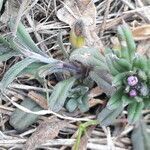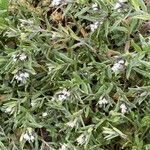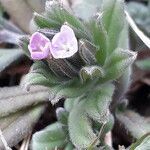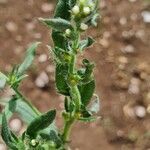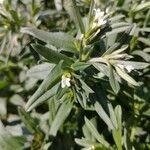Annual herb, up to 0.6 m high. Roots purplish red. Stems erect or decumbent, densely hairy. Leaves sessile; blade narrowly ovate or narrowly obovate, 15-45 x 3-8 mm, apex acute, margin entire, densely setulose. Flowers: bracteate; inflorescences terminal, cymes scorpioid; calyx > 1/2 as long as corolla tube, lobes with apices acute, indumentum whitish, hairs long, sparse; corolla with 5 well-differentiated, longitudinal bands of hairs extending from bases of lobes downwards to tips of anthers; stamens included, tube 5-7 mm long, white; Aug.-Nov. Fruit of 4 tuberculate nutlets, brownish or greyish, not shining, with hard pericarp.
Annual herb, up to 0.6 m high; greyish green, densely covered with appressed bristles. Stems branching from base. Leaves narrowly ovate or narrowly obovate, 15-45 x 3-8 mm, slightly clasping at base, apex acute, margins entire, densely setulose. Flowers in scorpioid cymes, cymes bracteate. Calyx with a white indumentum, enlarging in fruit. Corolla white; tube cylindric, 5-7 mm long, 5 hairy longitudinal bands inside, scale-like lobes at base. Flowering time Aug.-Dec. Fruit of ± ovoid nutlets, rugose and tuberculate.
Greyish green, annual herb, up to 600 mm tall, densely covered with appressed bristles. Leaves narrowly ovate to obovate. Flowers in scorpioid cymes, white, corolla tube hairy inside, with scale-like lobes at base, calyx with a white indumentum, enlarging in fruit. Nutlets ± ovoid, rugose and tuberculate.
Herb, 0.05-0.50(-0.90) m high. Indumentum of calyx whitish, calyx more than half as long as corolla tube, with long, sparse hairs, lobes acute. Corolla not longer than 10 mm. Nutlets tuberculate, brownish or greyish, not shining, with hard pericarp. Flowers white.
Roughly hairy annual to 60 cm. Leaves oblanceolate. Flowers in helicoid cymes, small, white. Nutlets ovoid, rugose-tuberculate.
A herb.
